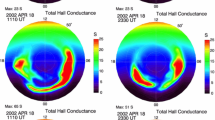Abstract
Reviewing briefly the recent progress in a joint program of specifying the polar ionosphere primarily on the basis of ground magnetometer data, this paper emphasizes the importance of processing data from around the world in real time for space weather predictions. The output parameters from the program include ionospheric electric fields and currents and field-aligned currents. These real-time records are essential for running computer simulations under realistic boundary conditions and thus for making numerical predictions of space weather efficient as reliable as possible. Data from individual ground magnetometers as well as from the solar wind are collected and are used as input for the KRM and AMIE magnetogram-inversion algorithms, through which the two-dimensional distribution of the ionospheric parameters is calculated. One of the goals of the program is to specify the solar-terrestrial environment in terms of ionospheric processes and to provide the scientific community with more than what geomagnetic activity indices and statistical models indicate.
Similar content being viewed by others
References
Lanzerotti L J. Space weather effects on technologies, In: Song P, et al., Space Weather, Geophys Monogra. Ser, 2001, 125: 11–22
Chapman S, Bartels J. Geomagnetism. Oxford: Oxford University Press, 1940
Iijima T, Potemra T A. The amplitude distribution of field-aligned currents at northern high latitudes observed by TRIAD. J Geophys Res, 1976, 81: 2165–2175
Mishin V M. The magnetogram inversion technique and some applications. Space Sci Rev, 1990, 53: 83–120
Kamide Y, Richmond A D, Matsushita S. Estimation of ionospheric electric fields, ionospheric currents, and field-aligned currents from ground magnetic records. J Geophys Res, 1981, 86: 801–813
Wolf R A, Kamide Y. Inferring electric fields and currents from ground magnetometer data: A test with theoretically derived inputs. J Geophys Res, 1983, 88: 8129–8135
Baker K B, Kamide Y. A comparison of ionospheric electric fields inferred from Scandinavian twin auroral radar experiment drift data and from global international magnetospheric study magnetometer data. J Geophys Res, 1985, 90: 1339–1345
Kamide Y, Baumjohann W. Magnetosphere-Ionosphere Coupling. Heidelberg: Springer Verlag, 1993. 178
Kamide Y, Masuda S, Shirai H, et al. The geospace environment data analysis system. Adv Space Res, 2003, 31: 807–812
Raeder J, Berchem J, Ashour-Abdalla M. The geospace environment modeling grand challenge: Results from a global geospace circulation model. J Geophys Res, 1998, 103: 14787–14796
Papadoupoulos K, Goodrich C C, Wiltberger M, et al. The physics of substorms as revealed by the ISTP. Phys Chem Earth, 1999, 24: 189–198
Gombosi T I, De Zeeuw D L, Groth C P T, et al. Magnetospheric configuration for Parker-spiral IMF conditions: Results of a 3D AMR MHD simulation. Adv Space Res, 2000, 26: 139–150
Tanaka T. The state transition model of the substorm onset. J Geophys Res, 2000, 105: 21081–21090
Richmond A D, Kamide Y. Mapping of electrodynamic features of the high-latitude ionosphere from localized observations: Technique. J Geophys Res, 1988, 93: 5741–5759
Ridley A J, Moretto T, Ernstroem P, et al. Global analysis of three traveling vortex events during the November 1993 storm using the assimilative mapping of ionospheric electrodynamic technique. J Geophys Res, 1998, 103: 26349–26359
Zwickl R D, Doggett K, Sahm S, et al. The NOAA Real-Time Solar-Wind (RTSW) system using ACE data. Space Sci Rev, 1998, 86: 633–653
Papitashvili V O, Belov B A, Faermark D S, et al. Electric potential patterns in the northern and southern polar regions parameterized by the interplanetary magnetic field. J Geophys Res, 1994, 99: 13251–13261
Weimer D R. Models of high-latitude electric potentials derived with a least error fit of spherical harmonic coefficients. J Geophys Res, 1995, 100: 19595–19604
Shirai H, Kamide Y, Kihn E A, et al. Near real-time calculation of ionospheric electric fields and currents using GEDAS. Chinese J Astron Astrophys, 2003, 3: 375–380
Ahn B-H, Richmond A D, Kamide Y, et al. An ionospheric conductance model based on ground magnetic disturbance data. J Geophys Res, 1998, 103: 14769–14780
Kamide Y, Shue J-H, Hausman B A, et al. Toward real-time mapping of ionospheric electric fields and currents. Adv Space Res, 2000, 26: 213–222
Kappenman J G. Effects of geomagnetic disturbances on power systems. Power Eng Rev, IEEE, 1989, 9: 15–30
Kappenman J G. Advanced geomagnetic storm forecasting for the electric power industry. In: Song P. et al., eds. Space Weather, Geophys Monogra. Ser, 2001, 125: 353–358
Boteler D H, Pirjola R J, Nevanlinna H. The effects of geomagnetic disturbances on electrical systems at the earth’s surface. Adv Space Res, 1998, 22: 17–30
Pirjola R, Viljanen A, Pulkkinen A, et al. Space weather risk in power transmission systems. Phys Chem Earth, 2000, 25: 333–343
Pulkkinen A, Lindahl S, Viljanen A, et al. Geomagnetic storm of 29–31 October 2003: Geomagnetically induced currents and their relation to problems in the Swedish high-voltage transmission system. Space Weather, 2005, 3: S08C03, doi:10.1029/2004SW000123
Lummerzheim D, Brittnacher M, Evans D, et al. High time resolution study of the hemispheric power carried by energetic electrons into the ionosphere during the May 19/20, 1996 auroral activity. Geophys Res Lett, 1997, 24: 987–990
Germany G A, Parks G K, Brittnacher M, et al. Remote determination of auroral energy characteristics during substorm activity. Geophys Res Lett, 1997, 24: 995–998
Fukushima N. Some remarks on the morphology of geomagnetic bays. J Geomag Geoelectr, 1959, 10: 164–174
Author information
Authors and Affiliations
Corresponding author
Additional information
Based on the Opening Lecture, delivered on November 10, 2007 at the occasion of the 12th Conference on Space Physics in China, which was held in Sanya, Hainan, China
Rights and permissions
About this article
Cite this article
Kamide, Y., Ieda, A. Mapping of ionospheric parameters for space weather predictions: A concise review. Sci. China Ser. E-Technol. Sci. 51, 1589–1599 (2008). https://doi.org/10.1007/s11431-008-0254-y
Received:
Accepted:
Published:
Issue Date:
DOI: https://doi.org/10.1007/s11431-008-0254-y




